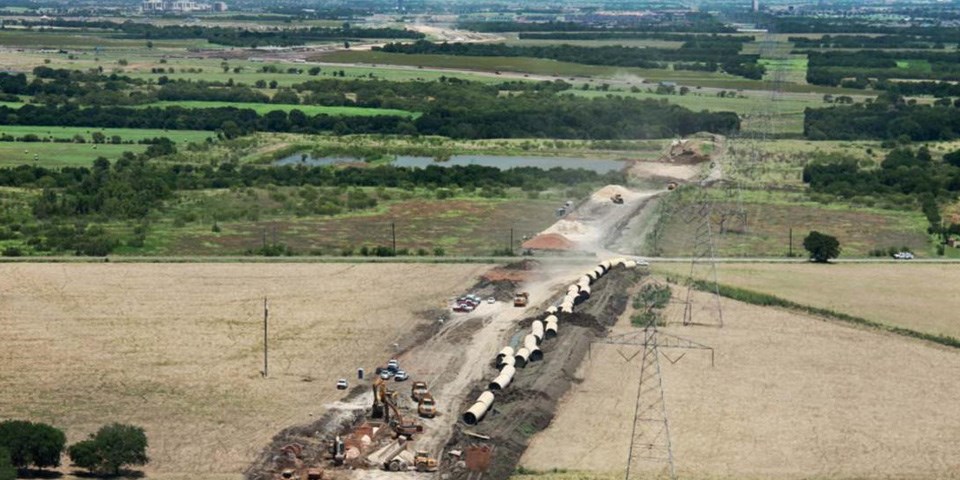Article by Daniel Sweet
___
When complete, the USD 2.3 billion Integrated Pipeline Project (IPL) will be the largest water transmission system in Texas. Project highlights include a 150-mile pipeline, three lake pump stations, and three booster pump stations delivering a required capacity of 350 million gallons per day (MGD) of raw water. This increase is much needed in the region—by 2060, the population of North Central Texas is expected to grow from 4.5 million to 13 million residents. By integrating the new pipeline and pumping stations with TRWD’s pre-existing distribution network, the district hopes to ensure a steady supply of water well into the future.
The IPL is being constructed in five phases, and phase one, which began in May 2014 and included the installation of 70 miles of 84-inch to 108-inch pipeline, wrapped up in spring of this year. In 2017, the IPL made Valve World news for a record-breaking achievement: the installation of what is reportedly the largest gate valve in the world. With construction on phase one complete, Valve World now brings you more detail.
Largest gate valve
TRWD planners contracted Blackhall Valves of the United Kingdom to source the crucial gate valves needed to regulate the water in the longest sections of the IPL. Their resulting high-pressure DN2800 / 108-inch parallel faced metal seated gate valves are considered to be the world’s largest. Each valve weighs in at over 100 tons and stands 40 feet, or 12 meters, tall.
As a Blackhall case study describing the design of the valves explained, “Finite Element Analysis (FEA) was used to simulate and to predict both the structural behaviour of the valve during its operation and its capability of sealing under various flow and pressure conditions. The geometry of the components was optimised for enhanced stress distribution. The FEA results were validated by performing Strain Gauge testing on the valve. The design of the valve also incorporated external loading factors, for example, Computational Seismic (Modal) Analysis, performed to ensure the sustainability and robustness of the valve during earthquakes.”
Furthermore, in the manufacturing phase, an “Advanced Casting Simulation Programme was employed to optimise the casting process to ensure the castings were manufactured free from any residual stresses that could potentially develop during the solidification of the metal. This prevents any over-stressing of the components during operation and helps in ensuring the prolonged life of the valve. Extensive NDE and inspection techniques were also used to guarantee that the valves were manufactured to the highest quality standards.”
Six valves in total were produced by Blackhall for the IPL, designed in the UK and manufactured in the United States. James Blackhall, the Managing Director of Blackhall Engineering, commented: “It has been a joy working with TRWD. Both engineering teams worked exceptionally closely with a true sense of purpose to deliver this legacy project.”
Blackhall’s gate valves are not the only engineering innovation to come out of the IPL. The project has also led to a breakthrough in the integration of GIS, or a geographical information system, with real-time, as-built data.
As-built data, as opposed to the initial technical plans and drawings for a construction project, record accurate measurements of a given construction as it was completed in the field. According to an article in Advanced Engineering Informatics, as-built data on threedimensional constructions is used within civil infrastructure management “to actively track production during the construction phase of a project and for the automatic 3D-layout of built assets during their service lives.”
In the past, TRWD incorporated as-built data into their GIS model through a laborious and time-consuming process of data transmission between various stages: from the field to the central office, and finally to the GIS model. But by developing a network of wireless connected surveying equipment, TRWD was able to make as-built data available for immediate viewing across the organisation. As quoted in a report from The American Surveyor, manager of TRWD’s geospatial services group Mark McGuire said, “With this realtime system, we can determine immediately if a pipeline alignment is deviating from engineered plans, or if assets are not located in the original design locations. We can then alert crews to the error and rapidly ‘course-correct,’ saving the project from wasteful downtime and the unnecessary redo of pipeline construction.”
TRWD will continue to use its real-time GIS technology through phase two construction, which will begin in early 2020. Phase two aims to add 40 more miles of pipeline to the IPL, though more complete details, including whether additional Blackhall gate valves will be required, are not yet available.
Within the context of the United States, a water district is a local corporate entity that operates and maintains a water supply system in one or more provincial cities or municipalities. TRWD has been in operation since 1924 and is led by a publicly elected five-member board.
In addition to their expanding pipeline network, TRWD controls over 27 miles of floodway levees, more than 72 miles of river trails, and a 2,000-acre wetland water reuse project designed to increase future water supplies.


